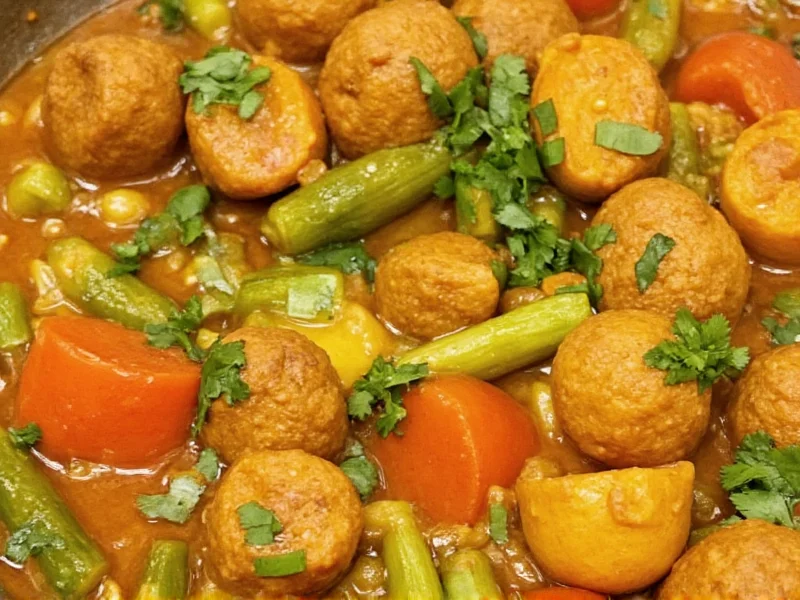Choosing the right vegetables can transform your curry from ordinary to extraordinary. The perfect curry vegetables balance texture, flavor absorption, and cooking time compatibility with the simmering process. This guide explores the science behind vegetable selection for curries, helping you create dishes with perfect consistency and maximum flavor integration.
Why Vegetable Selection Matters for Curry
Curry's extended cooking time creates unique challenges for vegetable selection. Unlike quick sautéed dishes, curry requires vegetables that can withstand prolonged simmering without disintegrating. The ideal curry vegetables share three key characteristics: structural integrity during cooking, flavor absorption capability, and complementary taste profiles with curry spices.
Top Vegetable Categories for Curry
Understanding vegetable categories helps create balanced curry dishes with varied textures and flavors. Grouping vegetables by cooking properties allows for strategic addition timing during preparation.
Root Vegetables: The Curry Foundation
Root vegetables form the hearty base of most curry dishes. Their dense structure withstands long cooking times while absorbing spices deeply. Potatoes remain the most versatile option, with waxy varieties like Yukon Gold holding shape better than starchy Russets. Sweet potatoes add natural sweetness that balances spicy curries, while carrots provide subtle sweetness and vibrant color.
Cruciferous Powerhouses
Cauliflower and broccoli bring substantial texture and excellent spice absorption. Cut cauliflower into uniform florets for even cooking. These vegetables work particularly well in drier curry preparations like bhuna or in coconut milk-based curries where they maintain firmness longer.
| Vegetable | Best Curry Type | Prep Tip | Cooking Time |
|---|---|---|---|
| Japanese eggplant | Bangladeshi, Thai | Cut into 2-inch chunks | 15-20 minutes |
| Sweet potato | Japanese, Thai | 1/2-inch cubes | 20-25 minutes |
| Spinach | Indian, Kashmiri | Add raw at end | 2-3 minutes |
| Chickpeas | Chana masala | Pre-cooked | 10-15 minutes |
Regional Vegetable Pairings
Different curry traditions feature distinctive vegetable combinations that have evolved with local agriculture and flavor preferences. Understanding these regional pairings helps create authentic dishes while expanding your culinary repertoire.
Indian Curry Vegetable Selection
Traditional Indian curries often feature "shak" combinations—specific vegetable pairings that create balanced flavor profiles. The classic aloo gobi combines potatoes and cauliflower, while navratan korma features nine vegetables including carrots, beans, and paneer. Southern Indian sambar typically includes drumstick, pumpkin, and lentils. For authentic results, add harder vegetables first and delicate greens at the end.
Thai Curry Vegetable Considerations
Thai curries work best with vegetables that complement coconut milk's sweetness. Bamboo shoots, Thai eggplant, and pea eggplant provide traditional texture contrasts. Bell peppers add color and sweetness that balances red and green curry pastes. When preparing Thai curries, add vegetables in stages based on density—starting with carrots and finishing with basil leaves.
Vegetable Preparation Techniques
How you prepare vegetables significantly impacts curry texture and flavor integration. Uniform cutting ensures even cooking, while strategic timing prevents mushiness. For root vegetables, cut slightly larger than you might for stir-fries since they'll continue cooking in the simmering liquid.
Consider partial pre-cooking for dense vegetables like potatoes and carrots. A quick 5-minute boil before adding to curry reduces overall cooking time while preventing other ingredients from overcooking. For eggplant, salting before cooking draws out bitterness and improves texture absorption.
Nutritional Benefits of Vegetable Curries
Well-constructed vegetable curries deliver impressive nutritional profiles. The combination of turmeric, black pepper, and healthy fats in curry sauces enhances absorption of fat-soluble vitamins from vegetables. Root vegetables provide complex carbohydrates and fiber, while leafy greens contribute iron and calcium. The spice blend itself offers anti-inflammatory benefits, particularly from turmeric's curcumin compound.
Troubleshooting Common Vegetable Curry Issues
Mushy vegetables remain the most frequent problem in homemade curries. This typically occurs when adding all vegetables simultaneously regardless of density. Solution: implement staged addition based on vegetable hardness. Another common issue involves vegetables not absorbing flavors, which often stems from insufficient cooking time or inadequate spice blooming in oil before adding liquid.
For watery curries, try roasting harder vegetables before adding to the curry base. This caramelizes natural sugars and reduces moisture content. If vegetables remain too firm, ensure your curry simmers gently rather than boiling vigorously, which can create uneven cooking.
Seasonal Vegetable Selection
Adapting your curry vegetables to seasonal availability improves both flavor and cost efficiency. Spring curries shine with asparagus, fresh peas, and baby turnips. Summer brings eggplant, zucchini, and bell peppers to their peak. Autumn offers ideal conditions for squash, sweet potatoes, and cauliflower. Winter curries benefit from hardy root vegetables and hearty greens like kale.
Seasonal cooking also aligns with traditional curry preparation methods, as most curry traditions developed around locally available produce. This approach naturally creates rotating menus that prevent recipe fatigue while maximizing flavor potential.
Creating Balanced Vegetable Curries
The most satisfying vegetable curries balance four key elements: texture variety, flavor complexity, color contrast, and nutritional completeness. Aim for at least three different vegetable textures in each curry—something soft (like potatoes), something firm (like carrots), and something delicate (like spinach).
Consider color psychology in plating: vibrant combinations of orange carrots, green spinach, and purple eggplant create visual appeal that enhances the dining experience. From a nutritional standpoint, different colored vegetables provide varied phytonutrients, making colorful curries inherently more balanced.











 浙公网安备
33010002000092号
浙公网安备
33010002000092号 浙B2-20120091-4
浙B2-20120091-4